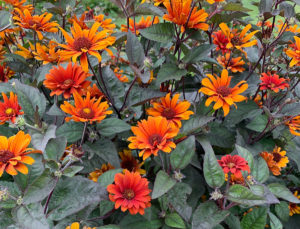False Sunflower ‘Bleeding Hearts’ (Heliopsis)
* Common name: False sunflower (a.k.a. smooth ox-eye) ‘Bleeding Hearts’

False sunflower ‘Bleeding Hearts’
Credit: Walters Gardens
* Botanical name: Heliopsis helianthoides var. scabra ‘Bleeding Hearts’
* What it is: False sunflowers are late-blooming, bee- and butterfly-friendly U.S.-native perennials that probably aren’t used more in our gardens because they’re so big – often hitting five to six feet tall.
‘Bleeding Hearts’ might change that for two reasons. One is that it’s a compact variety, growing a stocky three to four feet tall. The other is that this is the first false sunflower that isn’t yellow.
‘Bleeding Hearts’ produces four-inch-wide, sunflower-like blooms that open a fiery orange and mature to more of a gold/orange/red blend with dark-red centers. The flowers are long-lasting, too, beginning in July and continuing into mid-October.
The bronzy-green leaves and black stems add even more color interest.
* Size: Figure on four feet or less in height. Space two- to two-and-a-half-feet apart.
* Where to use: Although it’s more compact than the species, ‘Bleeding Hearts’ is still a back-of-the-border perennial. It’s a good choice for a sunny, warm-colored perennial garden, pollinator garden, or mixed garden. And it makes an excellent cut flower.
False sunflowers do best in full sun but are OK with everything from damp to dry soil, including fairly clayish soil.
* Care: Keep damp the first season, then water is usually not needed except in extended dry spells.
Scatter an organic granular fertilizer formulated for flowers over the bed in early spring.
Spent flowers can be snipped off to encourage continuing bloom, and then the plants can be cut back to the ground anytime between a killing frost and the end of winter.
You might need to stake plants, especially if rich soil is encouraging growth or if sunlight is lacking.
Divide at the end of winter if clumps are spreading beyond where you want or if you want to move divisions to new areas.
* Great partner: Pair with goldenrod, mums, and asters (other perennials that bloom late in the season) for a colorful early-fall garden that pollinators will love. Gold-variegated yucca, ornamental grasses, and any gold-foliage evergreen are good sun-loving structural partners.







